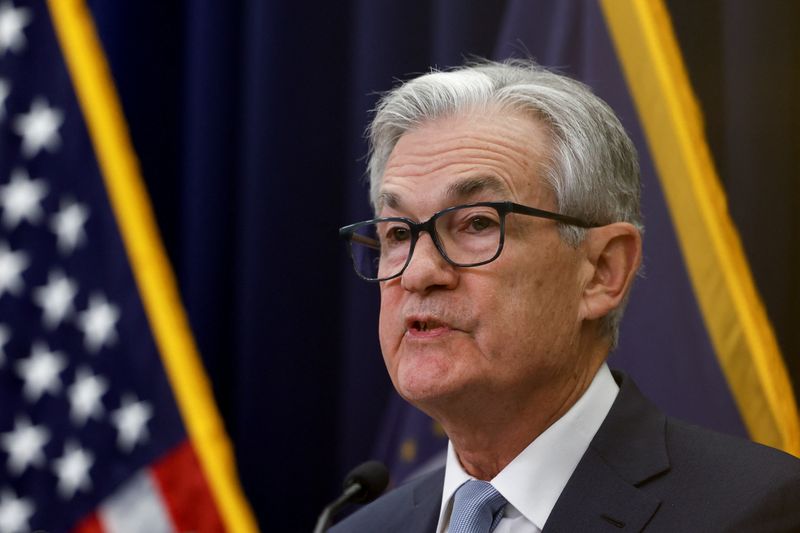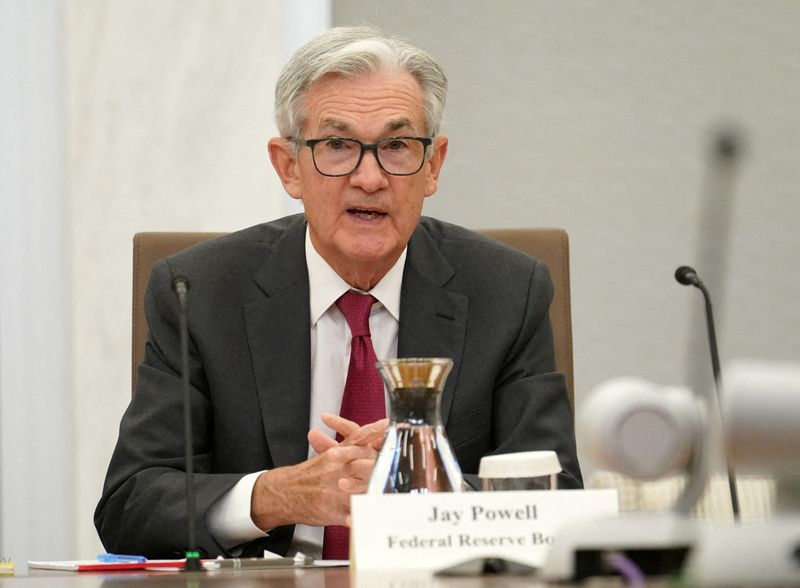By Howard Schneider, Ann Saphir and Michael S. Derby
WASHINGTON (Reuters) -The Federal Reserve will deliver more interest rate hikes next year even as the economy slips towards a possible recession, Fed Chair Jerome Powell said on Wednesday, arguing that a higher cost would be paid if the U.S. central bank does not get a firmer grip on inflation.
Recent signs of slowing inflation have not brought any confidence yet that the fight has been won, Powell told reporters after the Fed's policy-setting committee raised its benchmark overnight interest rate by half a percentage point and projected it would continue rising to above 5% in 2023, a level not seen since a steep economic downturn in 2007.
Those rises in borrowing costs would come despite an economy that Fed officials projected will operate at near stall speed through next year, with an annual growth rate of 0.5% and an unemployment rate nearly a full percentage point higher by the end of 2023, well beyond the increase historically associated with a recession.
"We don't talk about this kind of recession, that kind of a recession. We just make these forecasts," Powell said in a news conference. "I wish there were a completely painless way to restore price stability. There isn't, and this is the best we can do."
He described the slow rate of economic growth penciled in by Fed officials next year as still "modest."
"I don't think it would qualify as a recession ... That's positive growth," the Fed chief said, even though "it is not going to feel like a boom."
But other aspects of the Fed's projections, notably a rise in the unemployment rate to 4.6% from the current 3.7%, are consistent with a downturn settling in as the central bank keeps its target policy rate at a "restrictive level" for at least the next two years.
The rate increase on Wednesday, which was approved unanimously by Fed policymakers and widely expected by financial markets, lifted the targeted policy rate to the 4.25%-4.50% range, with officials expecting it to rise to a level between 5.00% and 5.25% next year.
If anything, the bias is higher: seven of 19 policymakers projected even higher rates will be needed, and U.S. central bankers are unanimous that the risks are tilted towards higher-than-expected inflation rather than a surprise in the other direction.
Still, Powell said, repeating the hard-line on enforcing the Fed's 2% inflation target that he has developed through the year, "the largest amount of pain, the worst pain, would come from a failure to raise rates high enough and from us allowing inflation to become entrenched."
"The new economic projections imply an even higher pain threshold than before" for a Fed willing to tolerate the equivalent of about 1.6 million lost jobs, wrote Aneta Markowska, chief financial economist at Jefferies. "This suggests hawks still outnumber the doves by a significant margin."
Even with recent improvements, the Fed's preferred measure of inflation remains around triple the central bank's target, and policymakers project it will take at least three years to fall all the way back.
Only two of 19 Fed officials see the benchmark overnight interest rate staying below 5% next year, a sign of a still broad consensus to lean against inflation.
The message from the Fed on Wednesday also leaned against market expectations that recent data showing slowing inflation might push the central bank from its hawkish path and move policymakers toward cutting rates before the end of next year.
"Getting markets to hear that is key to fixing financial conditions" that have loosened in recent months as inflation data has improved, a move counter-productive to the Fed's inflation-fighting strategy, said Carl Riccadonna, chief U.S. economist at BNP Paribas (OTC:BNPQY).
'RESTRICTIVE ENOUGH'
The new statement was released after a policy meeting at which officials scaled back from the three-quarters-of-a-percentage-point rate increases delivered at the last four gatherings.
U.S. stocks closed lower on Wednesday. In the U.S. Treasury market, which plays a key role in the transmission of Fed policy decisions into the real economy, yields were little changed to slightly lower. The dollar dipped against a basket of currencies.
"Taken together, today's statement and economic projections tell a simple, but persuasive story: this Fed isn't prepared to 'pivot' in any meaningful way until it sees sustained and conclusive evidence of a reversal in inflationary pressures," said Karl Schamotta, chief market strategist at Corpay.
Powell said the speed of coming rate rises is less critical now than earlier in the year when the central bank was "front-loading" rate hikes to catch up with accelerating prices.
"It's not as important how fast we go," he said, noting the bigger question facing policymakers is finding an "appropriately restrictive" endpoint and determining how long to stay there.

"Our focus right now is really on moving our policy stance to one that is restrictive enough to ensure a return of inflation to our 2% goal over time, it's not on rate cuts," Powell said.
"The inflation data received so far in October and November show a welcome reduction in the pace of price increases, but it will take substantially more evidence to give confidence inflation is on a sustained downward path," Powell said.
